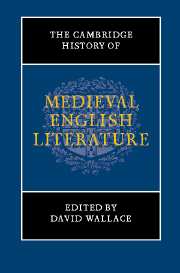Book contents
- Frontmatter
- I AFTER THE NORMAN CONQUEST
- II WRITING IN THE BRITISH ISLES
- III INSTITUTIONAL PRODUCTION
- Introduction
- 12 Monastic productions
- 13 The friars and medieval English literature
- 14 Classroom and confession
- 15 Medieval literature and law
- 16 Vox populi and the literature of 1381
- 17 Englishing the Bible, 1066–1549
- IV AFTER THE BLACK DEATH
- V BEFORE THE REFORMATION
- Chronological outline of historical events and texts in Britain, 1050–1550
- Bibliography
- Index of manuscripts
- Index
- References
13 - The friars and medieval English literature
from III - INSTITUTIONAL PRODUCTION
Published online by Cambridge University Press: 28 March 2008
- Frontmatter
- I AFTER THE NORMAN CONQUEST
- II WRITING IN THE BRITISH ISLES
- III INSTITUTIONAL PRODUCTION
- Introduction
- 12 Monastic productions
- 13 The friars and medieval English literature
- 14 Classroom and confession
- 15 Medieval literature and law
- 16 Vox populi and the literature of 1381
- 17 Englishing the Bible, 1066–1549
- IV AFTER THE BLACK DEATH
- V BEFORE THE REFORMATION
- Chronological outline of historical events and texts in Britain, 1050–1550
- Bibliography
- Index of manuscripts
- Index
- References
Summary
The word ‘friar’, the English reflex of the Middle French frere, means ‘brother’. Well before Chaucer’s time it had taken on as its commonest meaning a male religious of one of several new orders established in the Latin Church in the thirteenth century. These orders are sometimes called ‘fraternal’, in reference to their aspirations of spiritual brotherhood, and sometimes ‘mendicant’, in recognition of a commitment to ‘apostolic poverty’, a commitment theoretically requiring their members to live day-to-day by begging. The priests among the friars were called the ‘regular clergy’ to betoken that they lived under the specific rule (regula) of their order as opposed to the more numerous parish priests, the ‘secular clergy’, who carried on their work in ‘the world’ (saeculum). Mendicant religion emerged as a significant spiritual movement in the late twelfth and early thirteenth centuries. It took many and varied forms, some of a local and transitory character, and the Church soon stepped in to discourage the proliferation of new orders. When Chaucer writes of his friar that there was no smoother a talker ‘in alle the ordres foure’ (CT 1.210), he refers to the four fraternal orders recognized by the pope and currently active in England as throughout Europe. These were the Franciscans (Order of Friars Minor, often called the ‘greyfriars’ in England, and conventionally abbreviated OFM), the Dominicans (Order of Preachers, ‘blackfriars’, OP), the Carmelites (Order of the Hermits of the Blessed Virgin Mary of Mount Carmel, ‘whitefrairs’, O. Carm.), and the Augustinians (Order of Hermits of St Augustine, ‘Austin friars’, OESA).
- Type
- Chapter
- Information
- The Cambridge History of Medieval English Literature , pp. 349 - 375Publisher: Cambridge University PressPrint publication year: 1999
References
- 2
- Cited by

